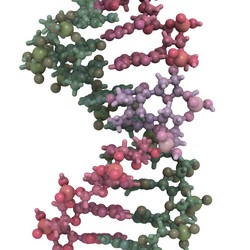DNA damage repair and tumorigenesis
Double-strand DNA breaks in mammalian cells are primarily repaired either by non-homologous end-joining or homologous recombination (HR). The recombination process involves exchange of strands between two homologous chromosomes and the resulting joint molecules form structures known as Holliday junctions (HJ). The proper completion of HR and especially dissolution of tumorigenic double HJs (dHJs) involves the so called BTRR enzymatic complex. BTRR contains helicase BLM in a stable complex with topoisomerase III and two oligonucleotide-binding factors – RMI1 and RMI2. BLM gene mutation is associated with Bloom's syndrome (BS), resulting in an elevated predisposition to several types of cancer at a young age. The EU-funded BLMCOMPLEX (Mechanism of Holliday junction dissolution by the Bloom’s syndrome complex) project researched the molecular mechanisms involved in the processing of HJ during HR in human cells. Using electron microscopy and purified BTRR complexes, researchers were able to optimise and visualise the binding conditions for the BTRR-dHJ complexes via electron microscopy. The results showed that two BTRR complexes bind the dHJs at the junction points. Preliminary results indicated that BLM forms dimers in solution. Researchers employed peptide arrays to identify the essential regions of interaction between BLM monomers as well as the components of the BTRR complex. The tools developed for this study will enable future studies on the mutant phenotypes in vitro and in vivo. This should aid in understanding the role of BLM/BTRR as well as determining the significance of the mutations found in BS patients. In addition to the BTRR pathway, human cells have another endonuclease-mediated HJ resolution. These involve the enzymes resolvases, which supposedly act upon dHJs that escape the BTRR complexes and mainly upon single HJs that BTRR cannot process. The study of these proteins on plasmid-based single and double HJ substrates demonstrated cleavage of the intermediates containing either single or double HJs in vitro. In conclusion, project results showed that both pathways of HJ resolution are able to deal with a variety of recombination intermediates during the HR of double-strand breaks in DNA.







